
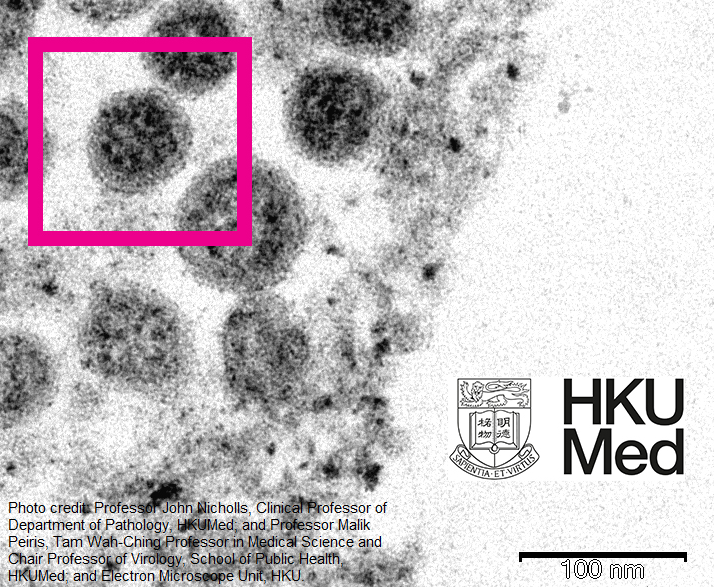
(写真のクレジット: ジョン・ニコルズ教授, 病理学教室臨床教授, HKUMed; そしてマリク・ピーリス教授, Tam Wah-Ching 医学科学教授およびウイルス学の主席教授, 公衆衛生学部, HKUMed; および電子顕微鏡ユニット, HKU。)
「Omicron の亜種について心配すべきかどうか」を分析する前に, まず、SARS-CoV-2 オミクロン変異体について知りましょう, 南アフリカでのみ出現した 9 11月 2021, 翌月末までに世界を席巻し、画期的な感染症などの言葉を生み出した, 3回目の投与とブースターが注目の検索に.
高度に変異したスパイクタンパク質により、ウイルスからの防御がさらに困難になる.
記事冒頭の電子顕微鏡画像は李嘉誠医学部が公開した世界初の「オミクロン」写真, 香港大学 (HKUMed) 12月に 8, 2021:
ウイルス粒子の表面は王冠のような形をしています, スパイクプロテインはどれですか (Sプロテイン) ウイルスが細胞に侵入するために使用する.
ウイルスはこれらのスパイクタンパク質に依存して細胞表面の受容体に結合します。, 細胞のエンドサイトーシス機構を引き起こして危険な敵への扉を開き、細胞を捕らえて新しいウイルス粒子の複製を助け、より多くの細胞に感染できるようにします。.
したがって, スパイクタンパク質は、ウイルスが細胞に侵入するための鍵となるだけでなく、ウイルスを「正確に」識別して捕捉するように免疫系を訓練するためのワクチンの標的でもある. 突然変異の程度が大きいほど, ワクチンによって誘導された抗体が見逃されやすくなる.
ローマの名門バンビーノ・ジェス病院が11月に公開したスパイクタンパク質「デルタ」と「オミクロン」の三次元モデルを比較した以下の写真より 27, 2021, オミクロンがデルタよりも伝染しやすい理由が理解できます.
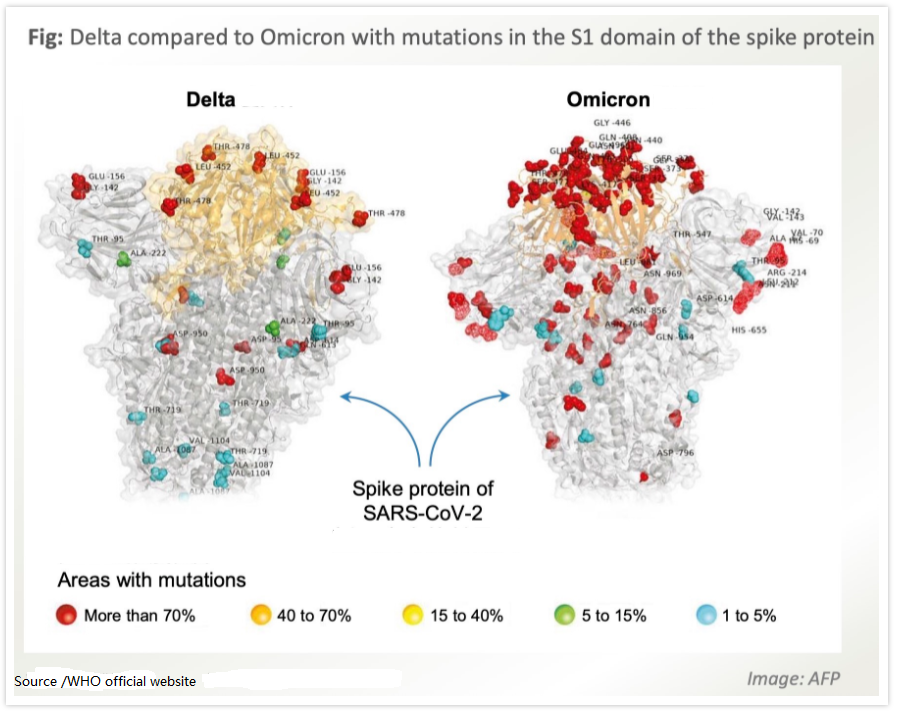
(出典/WHO公式サイト)
色でマークされた位置は、元のウイルス株とは異なる変異領域です。. 分析によると, 少なくともあります 32 「オミクロン」のスパイクタンパク質の重要な変異, 「デルタ」を遥かに超える, そして高度に変異した (赤) ヒトの細胞と相互作用する位置にも領域が集中している.
このような突然変異により、「オミクロン」が人間の細胞に侵入して繁殖しやすくなります。, 人々の間で広がり、既存のワクチンによる免疫を回避する, 画期的な感染または再感染につながる.
「オミクロン」は気管支には感染しやすいが、肺には浸透しにくい.
HKUMedが12月に公式ウェブサイトで発表した研究結果によると、 15, Omicron の亜種は周囲で複製します 70 人間の気管支ではデルタや元の新型コロナウイルス株よりも何倍も速いが、人間の肺組織では効果が劣る.
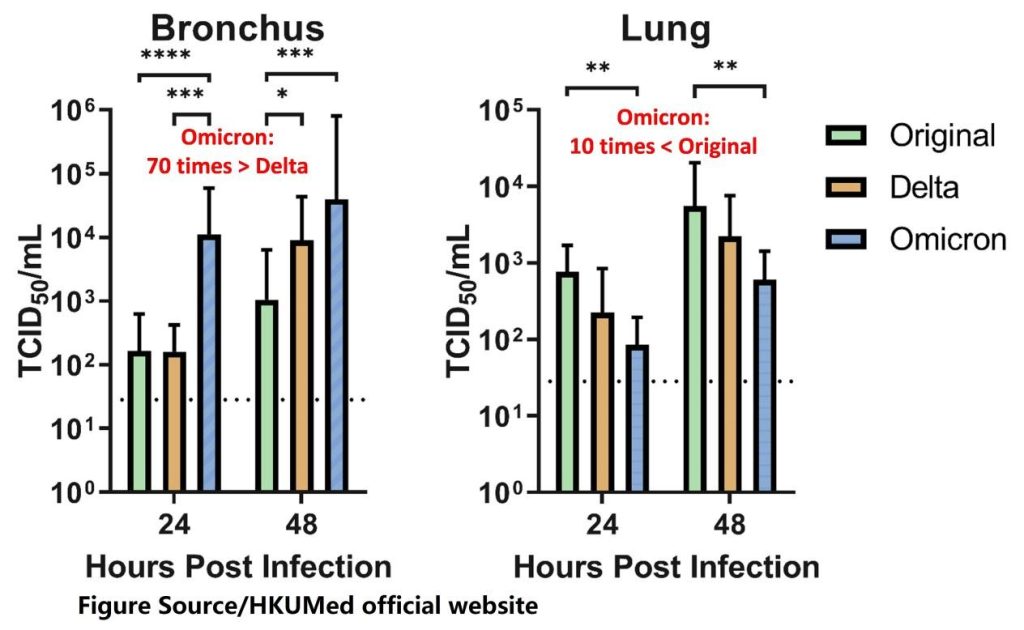
(図出典/HKUMed公式ウェブサイト)
これは、「オミクロン」が感染の初期症状にもかかわらず急速に蔓延する理由を説明する可能性があります。 (喉のかすれ, 鼻づまり) 風邪と間違えられやすいですが、病気の重症度は比較的低いです.
ただし、「オミクロン」は重篤な症状を引き起こす可能性が低いため、軽視しないでください. 最終的にどんな結末が待っているのか誰にも分からない?
さらに何が, 「デルタ」と「インフルエンザ」が今も同時に我々を見つめている! それらを回避する最善の方法は、毎日免疫力を高いレベルに維持するよう努めることです.
したがって、「オミクロン」についてはあまり心配する必要はありませんが、予防策には注意する必要があります。.
細胞が Omicron 変異体に感染するとどうなるか?
HKUMed が提供した次の電子顕微鏡画像を見てください。.
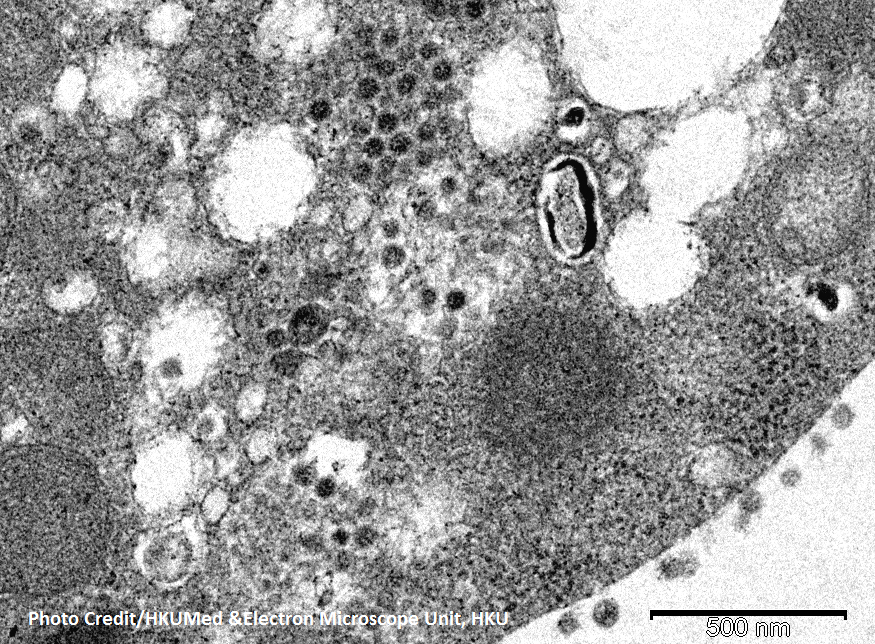
(写真提供/HKUMed & 電子顕微鏡ユニット, HKU)
これはベロの電子顕微鏡写真です (猿の腎臓) 細胞 24 SARS-CoV-2のオミクロン変異体に感染してから数時間後. 細胞小胞内で多くのウイルスが複製されていることがわかります。, そして複製していたウイルス粒子が細胞表面に放出され、仕事をする準備が整っています。.
これはウイルスが「細胞ひとつ」で複製した新型ウイルスにすぎない. 本当に速いです! 幸いなことに, それは単なる in vitro 細胞実験です. それが生体内で起こった場合, どれだけの細胞が苦しむか分からない, そして現時点での感染者は無症状であることが多い; 誰かが間違っていると感じ、それを防ぎたいとき, もう手遅れです!
感染後, 一部のウイルスは細胞内に存在し、一部のウイルスは細胞外に存在します. 免疫システムはさまざまな方法でウイルスに対処します.
ワクチン接種によって誘導される抗体は捕捉することしかできません。 (中和する) 細胞の外のウイルス. ウイルスが細胞に侵入した瞬間に阻止できれば, 物事は比較的単純です; ウイルスが細胞に感染すると, 免疫細胞は、細胞内でのウイルス複製をブロックし、ウイルス増殖の量と速度を低下させるためにインターフェロンを分泌する必要があり、感染細胞を殺すために「キラーT細胞」または「ナチュラルキラー細胞」も必要です。.
抗体によって捕らえられたウイルスも感染細胞を死滅させたウイルスも、ビットを拾うためにマクロファージが必要です. この前に, マクロファージと樹状細胞も「ヘルパー T 細胞」にシグナルを送るのに役立つはずです, 免疫システムの最高司令官, その後、細胞傷害性 T 細胞と中和抗体を生成するための正しい命令が出されます。.
ワクチン接種により抗体が誘導される可能性がある, 抗ウイルス薬は細胞内でのウイルスの複製を阻害し、ウイルスの拡散を遅らせることができます。. However, 本当にウイルスを撲滅するには, 免疫システムのあらゆる要素が完全に動員され強化される必要がある.
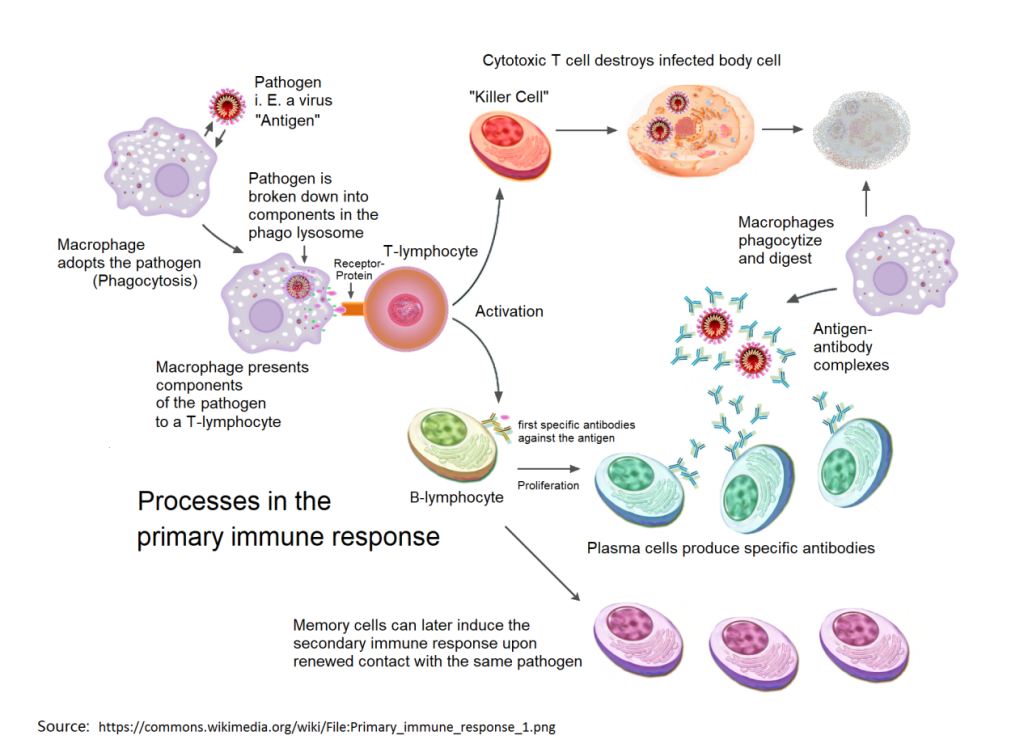
それで, 予防接種を受けた後, 免疫細胞を総合的に増やす方法, 免疫反応を強化する, 免疫機能を改善する, 免疫バランスを促進する, 過剰な炎症を避ける?
1990年代の研究以来, マンネンタケ 樹状細胞の成熟を促進することが証明されています, T細胞の分化を調節する, B細胞による抗体の産生を刺激する, 単球-マクロファージの分化を促進する, ナチュラルキラー細胞の活性を高めます, さまざまな免疫細胞の増殖やさまざまなサイトカインの分泌を助けます。, 免疫システムに包括的な調節効果をもたらします. これらの効果をすべて以下の図にまとめます。.
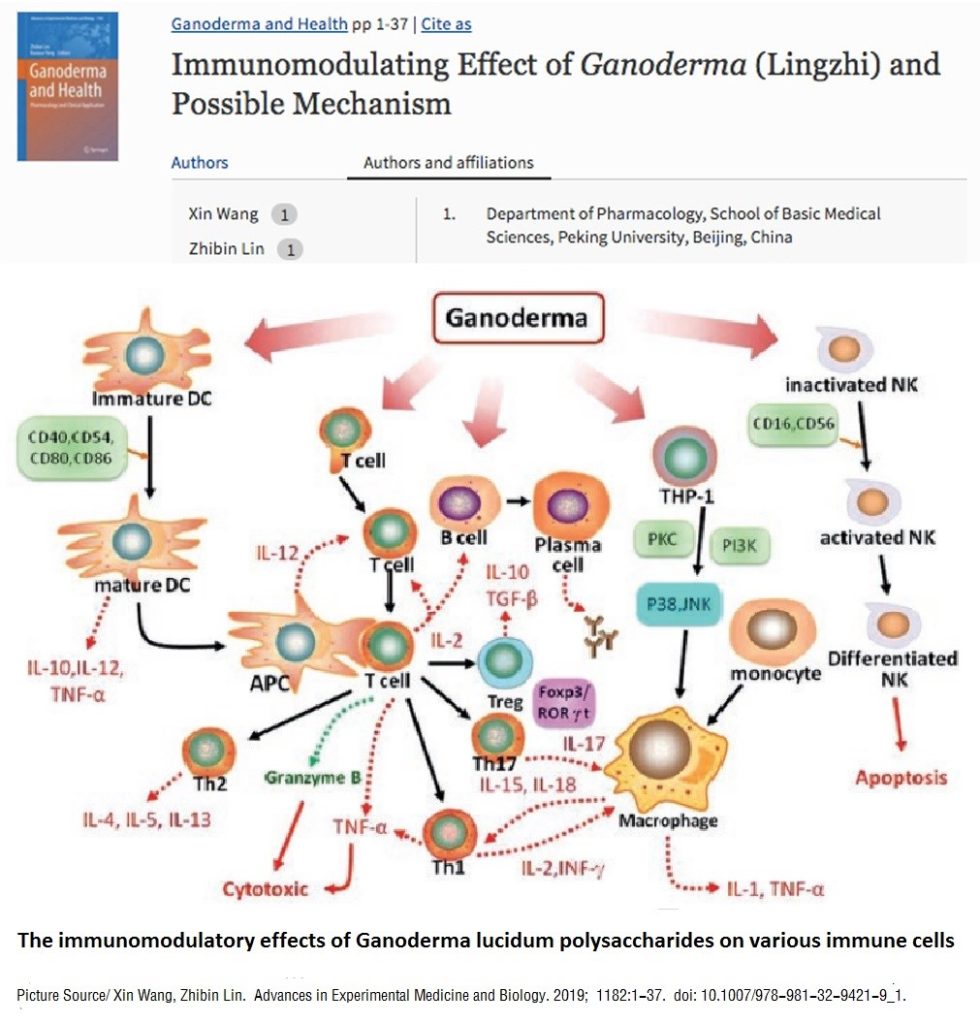
フォローアップでは, 「なぜ」をさらに詳しく説明します。マンネンタケ ウイルスと戦うために必要な免疫力を強化するのに役立ちます」といういくつかの論文が国際ジャーナルに掲載されています。. その前に, 食べ始めていただければ幸いですマンネンタケ 日々の免疫力がとても大事なので. 毎日良好な免疫システムを維持することによってのみ、私たちの毎日の安全を確保することができます.
終わり

★この記事は著者の独占的な許可を得て掲載されています, 所有権はGANOHERBに属します.
★上記作品は転載禁止です, GanoHerb の許可なく抜粋または他の方法で使用される.
★作品の使用を許諾されている場合, 許可の範囲内で使用し、出典を示す必要があります。: ガノハーブ.
★上記記載事項に違反した場合, GanoHerb は関連する法的責任を追及します.
★この記事の原文はWu Tingyaoが中国語で執筆し、Alfred Liuが英語に翻訳しました。. 翻訳に齟齬があった場合 (英語) そしてオリジナル (中国語), 本来の中国人が勝つだろう. 読者に質問がある場合, 原作者に連絡してください, MS. 呉廷耀.

千年の健康文化を継承する
すべての人の健康に貢献する



